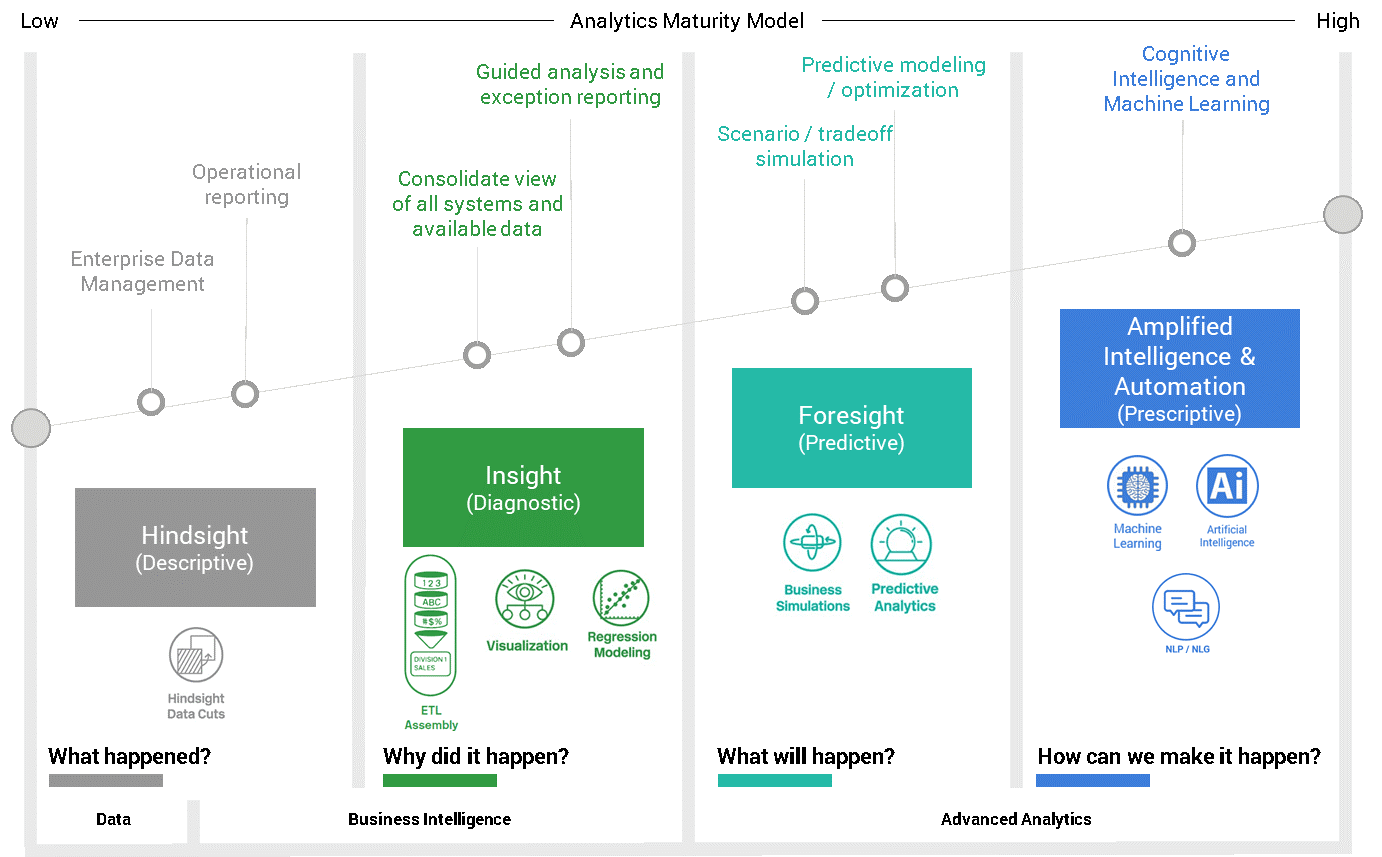
Data analytics journey: how do you know when you reach peak maturity?
An organization’s data analytics maturity journey moves from the organization using its data to tell a story of what happened to using its data to create a new revenue stream. The data maturity journey is a progression — and organizations need to acknowledge this and start where they can to begin the advancement of their maturity in the use of data.
The first article in our data maturity series highlighted that data maturity and organizational transformation go hand in hand. An organization that gets better at harnessing data will see transformation in its people, processes and overall business results. The second article focused on the different roles and responsibilities an organization has to fill as it becomes better at understanding and using its data. The third article laid out a simplified agile model for a data analytics project that would apply to any company regardless of where they sit in the data maturity model.
This article will help organizations understand when they have reached the payoff for their journey, where the organization has been transformed to use its data to drive better future results.

New data product, new customer value, new revenue stream
A business reaches the peak of data maturity when it can generate incremental revenue based on data it has accumulated and enhanced with other information, and then create a unique data product it puts into the market. There are many examples of this level of data maturity in practice:
- Facebook and Google generate most of their revenue by monetizing user data.
- Algorithmic trading where a computer program, following a specific set of instructions, can place stock trades at a speed and frequency impossible for humans to manage.
- Microsoft’s Cortana virtual assistant, which, among other things, leverages information found in a user’s email and calendar to send daily reminders about upcoming meetings or deadlines, creating new value for the end user.
- Several traditional retailers, including Target, Walmart and The Kroger Co., are generating substantial incremental revenue by anonymizing point-of-sale data and then selling it to packaged goods manufacturers. These retailers are driving new revenue by going beyond their core business — selling household goods or groceries — and selling market intelligence.
A company may be so successful creating what started as “incremental” revenue that they can spin off this part of the organization into an entirely new business.
Barriers to maturity
Sometimes business leaders may think that the more metrics they have, key performance indicators (KPIs), for example, the farther up the maturity curve they can go. What’s more important is to have the right KPIs — leading KPIs versus lagging KPIs — in other words, data that supports looking forward versus backward. For example, knowing sales opportunities in a pipeline is more valuable to the business than knowing sales revenue for the last quarter. In the manufacturing space, knowing projected forecast of units produced is more valuable than knowing actual units produced.
Other barriers to gaining the highest level of data maturity include:
- Not having the right people with the right skill sets in place to support data projects that use amplified intelligence and automation.
- Managing general business competitive pressures related to a data-driven product or service: Can the business articulate and demonstrate to the market the value of this new data product?
- Managing the fears that some may have relating to an autonomous data-driven product or program (consider the fear some have around autonomous driverless cars).
- Being unable to demonstrate the right level of security and trust in the way the business protects the data. This includes clearly de-identifying data and aggregating it at such a level that it does not put personal information in jeopardy.
The move to data maturity has to happen organically; the right leadership has to be in place that sees the potential in data becoming an asset that produces the incremental value for the organization. Early in the data maturity process, when a business unit or small team is trying to become proficient in identifying and properly maintaining its key data, they may focus on a “quick win” to demonstrate the value of improving its data maturity. At the high end of the data maturity curve, the business will have a mature development process, where it can quickly deploy new data products into the market and then employ a cycle of continuous improvement processes to enhance the products as necessary.
At that point, an organization may form an actual business unit around the data asset, eventually with its own revenue goals and targets. When the company starts focusing on the data asset becoming a revenue-producing product, leadership will be harnessing key functions of the business — marketing, sales, research and development, and IT — to support development of that new data-driven product.
Data security
As the business reaches the pinnacle of data maturity, an organization’s IT group remains foundational, making sure that the right technology and infrastructure is in place to support the business objectives. One of the key ways the IT department supports an organization’s data maturity is helping it secure its data, including customer or any other external data it uses as it creates more sophisticated data-based products and solutions.
As a business produces new data assets, it becomes the steward of those assets. How does the business ensure this asset is not being used maliciously either internally or externally? Is the organization protecting customers, as well as the business itself, from ransomware attacks? A company subject to an attack where its data is encrypted by a malicious actor becomes as helpless as a manufacturer that cannot access its physical plant because someone changed the locks on the door.
Creating value from an organization’s data is a journey. Like all journeys, it starts with small steps that create incremental value and matures over time. To reach that maturity an organization has to have a data-driven culture, executive buy-in and the drive to make key investments along the way. All of these qualities can lead to unique market offerings that will improve revenue and add value to the organization. Don’t discount your data; it is a key asset in today’s digital world.
Learn more about your data and begin your organizations digital transformation.



